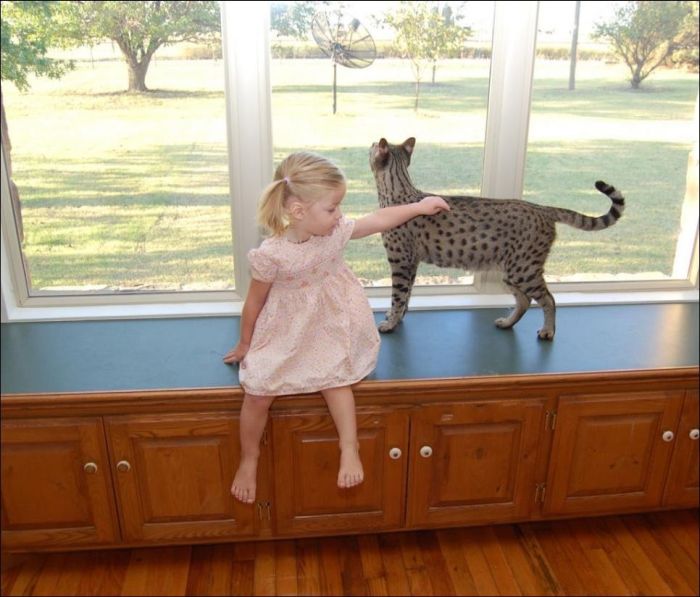|
|
Savannah Cat
|
Physical features
Savannah cats are one of the larger breeds of domesticated cats. The savannah's tall and slim build gives the appearance of greater size than their actual weight. Size is very dependent on generation and sex, with F1 hybrid male cats usually being the largest. F1 hybrid and F2 hybrids are usually the largest, due to the stronger genetic influence of the African Serval ancestor. A female F1 Savannah Cat named "Scarlett's Magic," measuring 45.9 centimeters or 18.1 inches from shoulder to toe, is the tallest domestic cat in the world, and measuring 108.5 centimeters or 42.7 inches from nose to tail. Male Savannahs tend to be larger than females. It is possible for early generation Savannahs to weigh up to 20 lbs or more, with the higher weight usually attributed to the F2 or F3 neutered males, though this is not the norm. Later generation Savannahs are usually between 10 to 15 lbs. Because of the random factors in Savannah hybrid genetics, there can be significant variation in size, even in one litter.
The coat of a Savannah depends a lot on the breed of cat used for the domestic cross. Early generations have some form of dark spotting on a lighter coat, and many early breeders employed "wild" looking spotted breeds such as the Bengal and Egyptian Mau for the cross to help preserve these markings in later generations. The International Cat Association (TICA) breed standard calls for brown spotted tabby (cool to warm brown, tan or gold with black or dark brown spots), silver spotted tabby (silver coat with black or dark grey spots), black (black with black spots), and black smoke (black tipped silver with black spots) only. In addition, the Savannah can come in nonstandard variations such as the classic or marble patterns, snow coloration (point), and blue or other diluted colors derived from domestic sources of cat coat genetics. Most breeders are trying to cull these non-standard colours out of the gene-pool, by selling non-standard coloured cats as pets, but some Savannah Breeders are interested in working with these colours to introduce them as new traits.
The overall look of an individual Savannah depends greatly on generation, with higher-percentage Savannah cats often having a more "wild" look. The domestic breed that is used will influence appearance as well. The domestic out-crosses for the Savannah breed that are permissible in TICA are the Egyptian Mau, the Ocicat, the Oriental Shorthair, and the Domestic Shorthair. In addition, some Savannah breeders use "non-permissible" breeds or mixes such as Bengal (for size and vivid spotting) and Maine Coon cats (for size) for the domestic parentage, but these "non-permissible" outcrosses can bring many unwanted genes as well. Outcrosses are rarely used these days, as there are now many fertile males available, and as a result, most breeders are exclusively doing Savannah-to-Savannah breedings. The main exception would be when using a Serval to produce F1 cats, and even then breeders prefer to use a Savannah with the Serval, rather than a non-savannah female.
|
|









